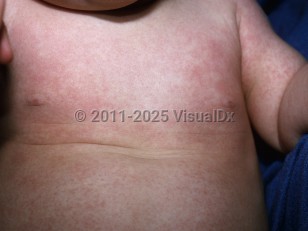Roseola in Infant/Neonate
Alerts and Notices
Important News & Links
Synopsis

Roseola (also known as sixth disease, exanthem subitum, and roseola infantum) is a mild, self-limited illness that mainly affects children and is defined by its classic exanthem. Human herpesvirus (HHV)-6 and HHV-7 have been implicated as causal agents. Antibodies, which are almost universally found in pregnant individuals, are protective prior to the age of 6 months. Infants with roseola are typically between the age of 6 months and 1 year, with 90% of cases occurring in children aged younger than 2 years. The disease course classically begins with a high fever typically greater than 38.9°C (102°F). The infant or child is otherwise well appearing, and the fever usually subsides on the fourth day.
The fever is followed immediately by the onset of asymptomatic, rose-pink, blanchable macules and papules 2-3 mm in diameter that begin on the trunk and may spread to the neck, upper extremities, and lower extremities. The rash typically lasts 1-2 days but can resolve more quickly.
Roseola is the cause of up to one-third of all febrile seizures and accounts for greater than 10% of undifferentiated febrile illnesses in children younger than 2 years.
While this disease is self-limited, it accounts for a large portion of emergency department and clinic visits for fever in infants and young children and often leads to unnecessary antibiotic prescriptions.
The fever is followed immediately by the onset of asymptomatic, rose-pink, blanchable macules and papules 2-3 mm in diameter that begin on the trunk and may spread to the neck, upper extremities, and lower extremities. The rash typically lasts 1-2 days but can resolve more quickly.
Roseola is the cause of up to one-third of all febrile seizures and accounts for greater than 10% of undifferentiated febrile illnesses in children younger than 2 years.
While this disease is self-limited, it accounts for a large portion of emergency department and clinic visits for fever in infants and young children and often leads to unnecessary antibiotic prescriptions.
Codes
ICD10CM:
B08.20 – Exanthema subitum [sixth disease], unspecified
SNOMEDCT:
54385001 – Exanthema subitum
B08.20 – Exanthema subitum [sixth disease], unspecified
SNOMEDCT:
54385001 – Exanthema subitum
Look For
Subscription Required
Diagnostic Pearls
Subscription Required
Differential Diagnosis & Pitfalls

To perform a comparison, select diagnoses from the classic differential
Subscription Required
Best Tests
Subscription Required
Management Pearls
Subscription Required
Therapy
Subscription Required
References
Subscription Required
Last Reviewed:08/03/2025
Last Updated:08/09/2025
Last Updated:08/09/2025
 Patient Information for Roseola in Infant/Neonate
Patient Information for Roseola in Infant/Neonate
Premium Feature
VisualDx Patient Handouts
Available in the Elite package
- Improve treatment compliance
- Reduce after-hours questions
- Increase patient engagement and satisfaction
- Written in clear, easy-to-understand language. No confusing jargon.
- Available in English and Spanish
- Print out or email directly to your patient
Upgrade Today

Roseola in Infant/Neonate

